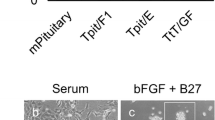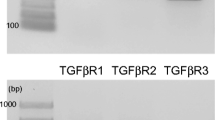Abstract
The functional development of pituitary cells depends on the expression of a combination of transcription factors and co-factors. Pituitary-specific transcription factor-1 (Pit-1) is required for the expression of growth hormone (GH), prolactin (PRL), and the thyroid-stimulating hormone β subunit (TSHβ) and acts synergistically with the estrogen receptor (ER) and GATA-binding protein 2 (GATA-2) to induce PRL and TSHβ expression, respectively. The glycoprotein hormone α subunit (αSU) is the first hormone to be expressed during pituitary development. In addition to being expressed in follicle-stimulating hormone, luteinizing hormone (LH), and TSH cells, αSU is reported to co-localize with GH in pituitary cells. These findings have led to the suggestion that the expression of Pit-1 in cells of the αSU-based gonadotropin cell lineage might also lead to the expression of GH. In this study, we transfected HP75 cells (derived from a human non-functioning pituitary adenoma that expressed αSU and LHβ) with Pit-1 by using an adenovirus FLAG-Pit-1 construct. Most of the transfected cells expressed GH mRNA, with fewer cells expressing PRL and TSHβ mRNA. The HP75 cells expressed the genes for ER and GATA-2, thus allowing their expression of GH, PRL, and TSHβ mRNA in response to Pit-1. These results support the hypothesis that GH can be induced in cells that possess an active αSU gene and shed light on the basic molecular mechanism that drives the development of GH, PRL, and TSHβ expression in the αSU-based gonadotroph lineage.





Similar content being viewed by others
Abbreviations
- αSU:
-
glycoprotein hormone alpha subunit
- GH:
-
growth hormone
- PRL:
-
prolactin
- TSH:
-
thyroid-stimulating hormone
- POMC:
-
pro-opiomelanocortin
- ACTH:
-
adrenocorticotropic hormone
- FSH:
-
follicle-stimulating hormone
- LH:
-
luteinizing hormone
- Pit-1:
-
pituitary-specific transcription factor-1
- ER:
-
estrogen receptor
- Tpit:
-
pituitary cell-restricted T-box factor
- NeuroD1:
-
neurogenic differentiation 1
- SF-1:
-
steroidogenic factor 1
- GATA-2:
-
GATA-binding protein 2
- DAX1:
-
dosage-sensitive sex-reversal, adrenal hypoplasia congenital, X chromosome
- Ptx1:
-
pituitary homeobox 1
- LHX3:
-
LIM homeobox protein 3
- Prop-1:
-
Prophet of Pit-1
- GHRH-R:
-
growth hormone-releasing hormone receptor
References
Asa SL, Kovacs K (1983) Histological classification of pituitary disease. Clin Endocrinol Metab 12:567–596
Barnhart KM, Mellon PL (1994) The orphan nuclear receptor, steroidogenic factor-1, regulates the glycoprotein hormone alpha-subunit gene in pituitary gonadotropes. Mol Endocrinol 8:878–885
Bertholon Gregoire M, Trouillas J, Guigard MP, Loras B, Tourniaire J (1999) Mono- and plurihormonal thyrotropic pituitary adenomas: pathological, hormonal and clinical studies in 12 patients. Eur J Endocrinol 140:519–527
Chang W, Zhou W, Theill LE, Baxter JD, Schaufele F (1996) An activation function in Pit-1 required selectively for synergistic transcription. J Biol Chem 271:17733–17738
Childs GV, Unabia G, Wu P (2000) Differential expression of growth hormone messenger ribonucleic acid by somatotropes and gonadotropes in male and cycling female rats. Endocrinology 141:1560–1570
Cohen LE (2000) Genetic regulation of the embryology of the pituitary gland and somatotrophs. Endocrine 12:99–106
Dasen JS, Rosenfeld MG (2001) Signaling and transcriptional mechanisms in pituitary development. Annu Rev Neurosci 24:327–355
Felix I, Asa SL, Kovacs K, Horvath E, Smyth HS (1994) Recurrent plurihormonal bimorphous pituitary adenoma producing growth hormone, thyrotropin, and prolactin. Arch Pathol Lab Med 118:66–70
Furuhata S, Kameya T, Tsuruta T, Naritaka H, Toya S (1994) Colocalization of growth hormone (GH) and glycoprotein subunit alpha in GH-producing pituitary adenomas in acromegalic patients. Acta Neuropathol (Berl) 87:568–571
Gage PJ, Brinkmeier ML, Scarlett LM, Knapp LT, Camper SA, Mahon KA (1996) The Ames dwarf gene, df, is required early in pituitary ontogeny for the extinction of Rpx transcription and initiation of lineage-specific cell proliferation. Mol Endocrinol 10:1570–1581
Gessl A, Freissmuth M, Czech T, Matula C, Hainfellner JA, Buchfelder M, Vierhapper H (1994) Growth hormone-prolactin-thyrotropin-secreting pituitary adenoma in atypical McCune-Albright syndrome with functionally normal Gs alpha protein. J Clin Endocrinol Metab 79:1128–1134
Gil del Alamo P, Pettersson KS, Saccomanno K, Spada A, Faglia G, Beck Peccoz P (1994) Abnormal response of luteinizing hormone beta subunit to thyrotrophin-releasing hormone in patients with non-functioning pituitary adenoma. Clin Endocrinol (Oxf) 41:661–666
Gordon DF, Lewis SR, Haugen BR, James RA, McDermott MT, Wood WM, Ridgway EC (1997) Pit-1 and GATA-2 interact and functionally cooperate to activate the thyrotropin beta-subunit promoter. J Biol Chem 272:24339–24347
Horn F, Windle JJ, Barnhart KM, Mellon PL (1992) Tissue-specific gene expression in the pituitary: the glycoprotein hormone alpha-subunit gene is regulated by a gonadotrope-specific protein. Mol Cell Biol 12:2143–2153
Horvath E, Lloyd RV, Kovacs K (1990) Propylthiouracyl-induced hypothyroidism results in reversible transdifferentiation of somatotrophs into thyroidectomy cells. A morphologic study of the rat pituitary including immunoelectron microscopy. Lab Invest 63:511–520
Ingraham HA, Albert VR, Chen RP, Crenshaw EB III, Elsholtz HP, He X, Kapiloff MS, Mangalam HJ, Swanson LW, Treacy MN, et al (1990) A family of POU-domain and Pit-1 tissue-specific transcription factors in pituitary and neuroendocrine development. Annu Rev Physiol 52:773–791
Jin L, Kulig E, Qian X, Scheithauer BW, Eberhardt NL, Lloyd RV (1998) A human pituitary adenoma cell line proliferates and maintains some differentiated functions following expression of SV40 T-antigen. Endocr Pathol 9:169–184
Jong MT, Raaka BM, Samuels HH (1994) A sequence in the rat Pit-1 gene promoter confers synergistic activation by glucocorticoids and protein kinase-C. Mol Endocrinol 8:1320–1327
Kovacs K (1991) The pathology of clinically non-functioning pituitary adenomas. Pathol Res Pract 187:571–573
Kovacs K, Scheithauer BW, Horvath E, Lloyd RV (1996) The World Health Organization classification of adenohypophysial neoplasms. A proposed five-tier scheme. Cancer 78:502–510
Kurotani R, Yoshimura S, Iwasaki Y, Inoue K, Teramoto A, Osamura RY (2002) Exogenous expression of Pit-1 in AtT-20 corticotropic cells induces endogenous growth hormone gene transcription. J Endocrinol 172:477–487
Lamolet B, Pulichino AM, Lamonerie T, Gauthier Y, Brue T, Enjalbert A, Drouin J (2001) A pituitary cell-restricted T box factor, Tpit, activates POMC transcription in cooperation with Pitx homeoproteins. Cell 104:849–859
Lanctot C, Gauthier Y, Drouin J (1999) Pituitary homeobox 1 (Ptx1) is differentially expressed during pituitary development. Endocrinology 140:1416–1422
Lefevre C, Imagawa M, Dana S, Grindlay J, Bodner M, Karin M (1987) Tissue-specific expression of the human growth hormone gene is conferred in part by the binding of a specific trans-acting factor. EMBO J 6:971–981
Li S, Crenshaw EB III, Rawson EJ, Simmons DM, Swanson LW, Rosenfeld MG (1990) Dwarf locus mutants lacking three pituitary cell types result from mutations in the POU-domain gene pit-1. Nature 347:528–533
Mangalam HJ, Albert VR, Ingraham HA, Kapiloff M, Wilson L, Nelson C, Elsholtz H, Rosenfeld MG (1989) A pituitary POU domain protein, Pit-1, activates both growth hormone and prolactin promoters transcriptionally. Genes Dev 3:946–958
Mukdsi JH, De Paul AL, Munoz S, Aoki A, Torres AI (2004) Immunolocalization of Pit-1 in gonadotroph nuclei is indicative of the transdifferentiation of gonadotroph to lactotroph cells in prolactinomas induced by estrogen. Histochem Cell Biol 121:453–462
Nelson C, Albert VR, Elsholtz HP, Lu LI, Rosenfeld MG (1988) Activation of cell-specific expression of rat growth hormone and prolactin genes by a common transcription factor. Science 239:1400–1405
Niiori Onishi A, Iwasaki Y, Mutsuga N, Oiso Y, Inoue K, Saito H (1999) Molecular mechanisms of the negative effect of insulin-like growth factor-I on growth hormone gene expression in MtT/S somatotroph cells. Endocrinology 140:344–349
Osamura RY, Watanabe K (1987) Immunohistochemical colocalization of growth hormone (GH) and alpha subunit in human GH secreting pituitary adenomas. Virchows Arch A Pathol Anat Histopathol 411:323–330
Osamura RY, Tahara S, Komatsubara K, Itoh Y, Kajiwara H, Kurotani R, Sanno N, Teramoto A (1999) Pit-1 positive alpha-subunit positive nonfunctioning human pituitary adenomas: a dedifferentiated GH cell lineage? Pituitary 1:269–271
Oyama K, Sanno N, Teramoto A, Osamura RY (2001) Expression of neuro D1 in human normal pituitaries and pituitary adenomas. Mod Pathol 14:892–899
Palomino T, Sanchez Pacheco A, Pena P, Aranda A (1998) A direct protein-protein interaction is involved in the cooperation between thyroid hormone and retinoic acid receptors and the transcription factor GHF-1. FASEB J 12:1201–1209
Poulin G, Turgeon B, Drouin J (1997) NeuroD1/beta2 contributes to cell-specific transcription of the proopiomelanocortin gene. Mol Cell Biol 17:6673–6682
Radovick S, Nations M, Du Y, Berg LA, Weintraub BD, Wondisford FE (1992) A mutation in the POU-homeodomain of Pit-1 responsible for combined pituitary hormone deficiency. Science 257:1115–1118
Sanno N, Teramoto A, Matsuno A, Itoh J, Takekoshi S, Osamura RY (1996) In situ hybridization analysis of Pit-1 mRNA and hormonal production in human pituitary adenomas. Acta Neuropathol (Berl) 91:263–268
Sanno N, Jin L, Qian X, Osamura RY, Scheithauer BW, Kovacs K, Lloyd RV (1997) Gonadotropin-releasing hormone and gonadotropin-releasing hormone receptor messenger ribonucleic acids expression in nontumorous and neoplastic pituitaries. J Clin Endocrinol Metab 82:1974–1982
Sanno N, Tahara S, Kurotani R, Matsuno A, Teramoto A, Osamura RY (2001a) Cytochemical and molecular biological aspects of the pituitary and pituitary adenomas—cell differentiation and transcription factors. Prog Histochem Cytochem 36:263–299
Sanno N, Teramoto A, Osamura RY (2001b) Thyrotropin-secreting pituitary adenomas. Clinical and biological heterogeneity and current treatment. J Neuro-Oncol 54:179–186
Sano T, Yamada S (1994) Histologic and immunohistochemical study of clinically non-functioning pituitary adenomas: special reference to gonadotropin-positive adenomas. Pathol Int 44:697–703
Shull JD, Gorski J (1984) Estrogen stimulates prolactin gene transcription by a mechanism independent of pituitary protein synthesis. Endocrinology 114:1550–1557
Simmons DM, Voss JW, Ingraham HA, Holloway JM, Broide RS, Rosenfeld MG, Swanson LW (1990) Pituitary cell phenotypes involve cell-specific Pit-1 mRNA translation and synergistic interactions with other classes of transcription factors. Genes Dev 4:695–711
Suhardja A, Kovacs K, Rutka J (2001) Role of transcription factors in the pathogenesis of pituitary adenomas: a review. J Neuro-Oncol 55:185–193
Thapar K, Kovacs K, Laws ER (1995a) The classification and molecular biology of pituitary adenomas. Adv Tech Stand Neurosurg 22:3–53
Thapar K, Kovacs K, Muller PJ (1995b) Clinical-pathological correlations of pituitary tumours. Baillieres Clin Endocrinol Metab 9:243–270
Tremblay JJ, Viger RS (2001) GATA factors differentially activate multiple gonadal promoters through conserved GATA regulatory elements. Endocrinology 142:977–986
Tremblay JJ, Lanctot C, Drouin J (1998) The pan-pituitary activator of transcription, Ptx1 (pituitary homeobox 1), acts in synergy with SF-1 and Pit1 and is an upstream regulator of the Lim-homeodomain gene Lim3/Lhx3. Mol Endocrinol 12:428–441
Umeoka K, Sanno N, Osamura RY, Teramoto A (2002) Expression of GATA-2 in human pituitary adenomas. Mod Pathol 15:11–17
Author information
Authors and Affiliations
Corresponding author
Additional information
This work was supported by Grants-in-Aid for Scientific Research Projects (B, 16390110) of the Ministry of Education Culture, Sports, Science, and Technology, Japan, and by the Research on Measures for Intractable Diseases Project of the Hypothalamo-Pituitary Dysfunction Research Group of the Ministry of Health, Labor and Welfare, Japan.
Rights and permissions
About this article
Cite this article
Miyai, S., Yoshimura, S., Iwasaki, Y. et al. Induction of GH, PRL, and TSHβ mRNA by transfection of Pit-1 in a human pituitary adenoma-derived cell line. Cell Tissue Res 322, 269–277 (2005). https://doi.org/10.1007/s00441-005-0033-z
Received:
Accepted:
Published:
Issue Date:
DOI: https://doi.org/10.1007/s00441-005-0033-z




